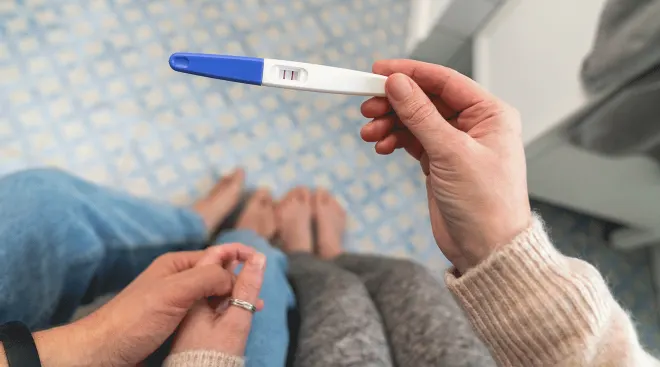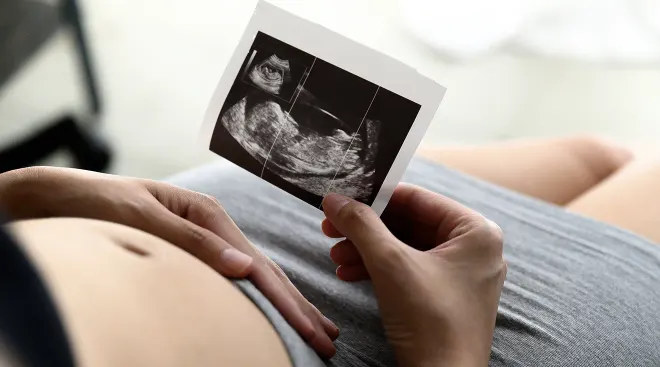Your Comprehensive Guide to Non-Invasive Prenatal Testing
Parenthood is chock-full of surprises—that’s what makes it exciting! And there’s much about your unborn baby’s future that’s unknown: The color of their eyes, whether they’ll have your dimples or your partner’s smile, what their first words or favorite foods will be. When it comes to your child’s health, however, surprises aren’t as welcome. But thanks to a relatively new screening method known as non-invasive prenatal testing (NIPT), doctors now have a better idea of what the future holds for baby’s wellbeing. Read on to find out whether the NIPT test is right for you and your child.
Non-invasive prenatal testing screens for chromosomal abnormalities in your developing baby. Unlike chorionic villus sampling (CVS) and amniocentesis (amnio)—which are prenatal tests that test samples extracted from the uterus or placenta—NIPT is performed using a blood sample taken from the pregnant mother. That’s why it’s known as non-invasive.
The quick blood sample is taken from Mom via needle and syringe. NIPT then analyzes tiny fragments of DNA in the blood called cell-free DNA (cfDNA). Because the mother’s bloodstream contains a mix of cfDNA from her own cells as well as cells shed from the placenta, the screening is able to detect possible genetic abnormalities in baby’s cfDNA. Not only is the process way more comfortable for Mom than invasive procedures, but whereas CVS and amnio pose a (slight) chance of miscarriage, NIPT can be done without any risk to baby. And that’s huge.
Typically, the test isn’t performed until at least week 10 of pregnancy. That’s because before that point, there may not be enough cfDNA from the placenta in the mother’s bloodstream to identify fetal chromosomal abnormalities. Results are usually available in 8 to 14 days.
While it’s not the primary purpose of NIPT, because the test analyzes baby’s DNA, your NIPT test results can also tell you the sex of your child. That means parents who choose to do NIPT testing can find out if they’re expecting a boy or girl around 11 or 12 weeks of pregnancy, instead of waiting for the 20-week ultrasound.
First, it’s important to understand that NIPT is a screening test—meaning it can tell you the chances of your child having a chromosomal abnormality. It can’t tell you definitively whether or not baby has an abnormality. (For that, you’d need to have a CVS or amnio.)
Different NIPT tests can screen for different chromosomal disorders, but most screen for Down syndrome, trisomy 13 (Patau syndrome) and trisomy 18 (Edwards syndrome). Additionally, some tests might screen for:
- Trisomy 16
- Trisomy 22
- Triploid syndrome—this occurs when baby is born with an extra set of chromosomes in their cells
- Sex chromosome aneuploidies—this occurs when baby is born with an abnormal number of sex chromosomes, which can lead to disorders such as Turner syndrome and Klinefelter syndrome
- Disorders caused by chromosomal deletion, like Prader-Willi syndrome
- Single gene disorders
Doctors typically recommend NIPT testing for women whose pregnancies are considered high-risk for a chromosomal abnormality, says Katelynn Sagaser, MS, CGC, a certified genetic counselor and genomic health education manager with 23andme.
The pregnancy might be considered high-risk if:
- The mother (or egg donor) is 35 or older
- The woman has already had an abnormal prenatal screening result
- A fetal abnormality was detected on a sonogram
- One parent has a chromosomal abnormality
- The mother has had a previous pregnancy with a chromosomal abnormality
That said, all women at any age have a chance of having a baby with a birth defect, which is why many moms-to-be who don’t fall into these buckets say yes to non-invasive prenatal testing.
On the flip side, women with high-risk pregnancies may decide against the screening test if they feel the results wouldn’t affect whether they go forward with the pregnancy. “As parents-to-be consider the option of NIPT, they may want to first spend some time reflecting on what kind of information is helpful and empowering to them during their pregnancy,” Sagaser says. “The term ‘healthy baby’ has different meanings to different people, and NIPT may give parents more or less information than they want regarding the health of their little one.”
NIPT test accuracy depends on what you want to learn from the test. There’s a 99 percent chance that Down syndrome will be detected by NIPT. “While NIPT is a very good screening test for trisomy 21 (Down syndrome) and trisomy 18, it’s not nearly as good for trisomy 13 and sex chromosome abnormalities,” says John Williams, MD, the director of reproductive genetics service at Cedars-Sinai Medical Center in Los Angeles. Some studies have shown the detection rate for trisomy 18 and 13 to be 96.3 percent and 91 percent, respectively.
“It’s important to understand that NIPT is not a diagnostic test, and can have false positive results, false negative results and possibly more confusing results,” Sagaser says. The false positive rate (when the test incorrectly detects a condition) for trisomy 21, 18 and 13 is small—less than 1 percent—but parents-to-be should be aware that the test has limitations, and that certain factors can increase the chance of an inaccurate or failed reading.
NIPT testing may also be less effective if you:
- Are pregnant with twins or multiples
- Are obese
- Used a donor egg to get pregnant
- Are less than 10 weeks pregnant
- Are taking certain blood thinners
Because non-invasive prenatal testing is generally very effective, a normal result can be a massive relief for parents-to-be. They may decide to opt out of future CVS and amnio diagnostic testing, since the slight risk of miscarriage may no longer seem worth it. “If a parent receives normal results from NIPT, there is a very low chance—usually less than one percent—that their baby would later be diagnosed with one of the conditions included on the NIPT,” Sagaser says.
A positive result, on the other hand, can also be empowering for moms- and dads-to-be. “Some parents might benefit from learning more about the condition, preparing to raise a child with a health issue or disability, making different plans for the pregnancy (such as ending the pregnancy or creating an adoption plan) or starting possible treatment sooner after birth,” Sagaser says.
NIPT testing is non-invasive, so there are no physical risks for mom or baby, but it’s possible for NIPT to cause emotional anxiety. “Some people may feel the chance of a false positive result, or even the wait for the screening result, may cause significant stress and worry,” Sagaser says. It’s something to consider when deciding if the NIPT test is right for you and your family. If you’re unsure, talk to your doctor or genetic counselor about whether knowing your child’s risk status would be useful to you as your prepare for baby’s arrival, Sagaser suggests.
Remember: NIPT is a screening test, not a diagnostic test. A positive result doesn’t mean baby will 100 percent be born without a chromosomal disorder, and a negative result isn’t a guarantee your child will be born without a genetic or chromosomal abnormality. That’s why it’s important for expectant parents to avoid taking non-reversible actions, such as terminating the pregnancy, based on NIPT results alone. “If you get a positive NIPT screening, you should definitely have diagnostic testing to confirm the findings,” such as CVS or amnio, Williams says.
NIPT is becoming more readily available to pregnant women, but the cost will ultimately depend on your insurance plan. “When a pregnant patient has a medical indication for NIPT, most insurance policies contribute to the cost of the test,” Sagaser says. But if your insurance company doesn’t cover NIPT, many laboratories have flexible programs that can help with the cost of NIPT, which can range from $800 to $3,000. If you have any questions about what you’d pay for an NIPT test, ask your doctor’s office to direct you to the NIPT billing team. They should be able to provide you with an estimate.
There’s no one right answer! You may have heard about certain branded NIPT tests, such as the Harmony test and Panorama test. When figuring out which is the best NIPT test for you, your doctor will take certain factors into account, including your age, weight, whether an egg donor was used, what the test screens for (different tests may screen for different abnormalities) and which tests are covered by your insurance. Together, you and your doctor—or your genetic counselor—can determine which NIPT test is best for you and your pregnancy plan.
Please note: The Bump and the materials and information it contains are not intended to, and do not constitute, medical or other health advice or diagnosis and should not be used as such. You should always consult with a qualified physician or health professional about your specific circumstances.
Plus, more from The Bump:
Katelynn Sagaser, MS, CGC, is a certified genetic counselor and genomic health education manager with 23andMe. Previously, she specialized in prenatal and preconception genetics at the Johns Hopkins Hospital in Baltimore, Maryland, as well as served as an assistant professor of gynecology & obstetrics in the Division of Maternal-Fetal Medicine.
John Williams, MD, is the director of reproductive genetics service at Cedars-Sinai Medical Center in Los Angeles. He earned his medical degree from UCLA and completed his residency at University of California, Los Angeles.
Learn how we ensure the accuracy of our content through our editorial and medical review process.
Navigate forward to interact with the calendar and select a date. Press the question mark key to get the keyboard shortcuts for changing dates.




















































